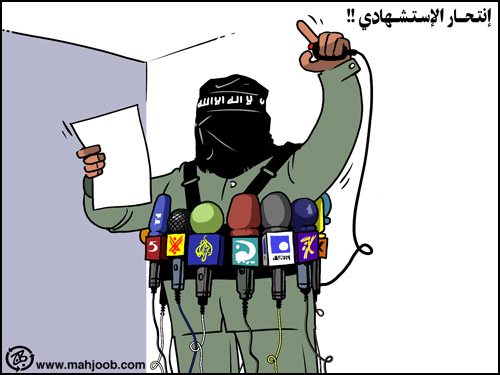
A visual culture of violence and shock has become omnipresent thanks to the ubiquitous and intensifying presence of media and technology. The Internet and 24-hour news shows are devoted to represent again and again images associated with terrorism and horror.
This visual representation integrates raw violence into our daily audiovisual dose. It subtly normalizes the horror of terrorism, massaging our minds and provoking a distinctive array of emotions with their sequences of barbaric violence and fear.
As a result of the visual production of fear and panic, the ordinary viewer is offered one sole possibility of solving the crisis of violence affecting the world: military intervention. Here, dominant media becomes a central tool for governments to back the different economic and sociopolitical interests behind each military intervention.
As a recent example, the visual branding that ISIS has adopted and that media is clearly exploiting to the maximum offers governments a “tangible” enemy to fight “legitimately”, regardless of the rampant violations of human rights they might commit.
Nowadays, and again born from the possibility of being continuously connected and informed by media, we feel we are in a continuous state of war. Always threatened, always ready to defend ourselves, always ready to fight back. Violence, terrorism and fear are a major element of our everyday life, regardless of who we are or where we are. And our militarized governments appear as the Godfather, the protector we all need to continue to back and finance for our own survival.
The centrality of technology and media not only in the depiction and communication of terrorism, but also in the balance of power, requires all of us to rethink and evaluate their role in democracy. It would be scary and a mistake if media, instead of promoting democratic practices and peaceful resistance, was just aligned with the dominant forces who consider terrorism as part of their political agenda and personal interests.
Sadly, to rethink the role of media and the Internet is a massive task that can only be carried out collectively, including in this effort all forces of society. However, there are basic points that reveal the complete involvement of media in the production of a culture of violence that we can instantly reconsider.
I am talking here about the media’s republication and airing of images such as the beheading videos showing the barbaric atrocity of ISIS, or previously, Saddam Hussein’s execution, or the 9/11 tragedy. These images are the perfect vehicle for the message the U.S. and other governments are trying to communicate to their citizens.
Back in 2003, the media made a hit out of Saddam Hussein’s execution, highlighting the chaos in which the country was living (partly as a result of the war launched by the U.S.). These images not only justify, but promote the politics of intervention and “war is the only solution” adopted by our elected leaders. On the other side, we rarely see videos of schools being built or new cures being found. Rarely.
The point this visual theatre of terrorism has reached should make us reflect on some important issues. Who have we become? How dehumanizing is it to watch certain images while sitting on our couch? How legitimate is it to distribute these images? Is this done for the sake of information or for the sake of fake stability and state control?
To begin to examine the society in which the coming generation is being educated is very necessary; much more necessary than what is being considered by most of us.
WE SAID THIS: Don’t miss These Are the Pictures You Should Share of Executed Jordanian Pilot Moaz al-Kasasbeh.


